Haswell Z87 Motherboard Preview: 50+ Motherboards from ASUS, Gigabyte, ASRock, MSI, ECS, Biostar and EVGA
by Ian Cutress on May 22, 2013 5:00 PM ESTMSI Z87
MSI have kept their cards relatively close to their chest on this one, except for one microsite detailing the core of their gaming and overclocking range. So far we have details on:
MSI Z87-GD65 Gaming
MSI Z87 MPower
MSI Z87 MPower Max
MSI Z87 XPower
It seems that the Big Bang moniker is finally gone, with MPower being the mid-range overclocking motherboard and the XPower being used for those sub-zero extremists.
MSI Z87A-GD65 Gaming
It was not too long ago that we had a look at the Z77A-GD65 Gaming, whereby MSI described to us that the Gaming range was initially intended for Haswell launch, but due to the extra delay added on by Intel they decided to forge ahead with a Z77 model. Back with that model, there was various limitations on what they could do (either physical or temporal), but Z87 has brought some of them out. Looking at the board we see larger heatsinks for the VRM and the Dragon, as well as Audio Boost:
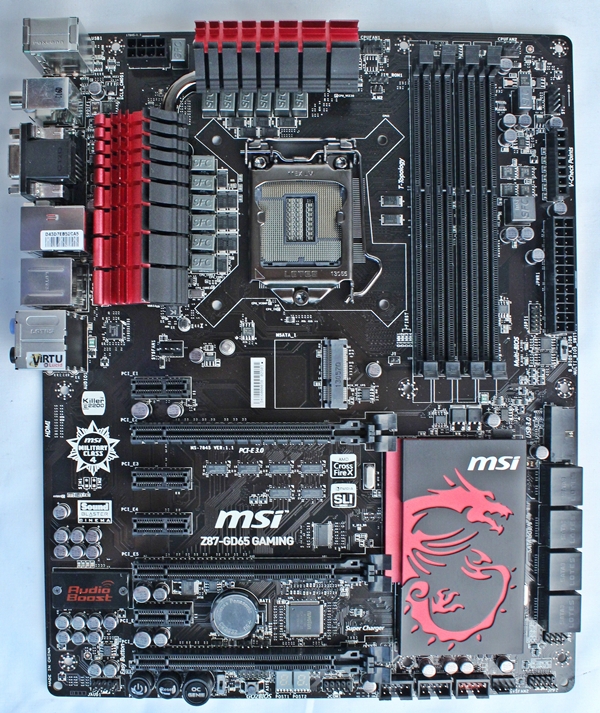
I was initially fooled by the lines on the board with the mSATA, thinking it was something special, but the fastener for the screw means that it is only an mSATA port. The big thing on the left hand side of the board is obviously Audio Boost, which given the motherboards already seen in this preview I would hazard a guess at an ALC1150 hiding under an EMI shield. The microsite states support for 600 ohm headphones as well.
On the board itself we see MSI voltage checkpoints, eight SATA 6 Gbps (it seems all are coming from the chipset?!), the classic OC Genie, also Go2BIOS for Windows 8 users/overclockers. Multi-BIOS also makes an appearance, selectable by a BIOS switch.
MSI Z87 MPower / MPower Max
Source: 59hardware, PC Authority
MSI seems to be splitting their overclocking motherboards into two groups – MPower for the lower cost 24/7 overclocking, and XPower for extreme overclock users. For the MPower, two versions are being released – a normal version and a MAX version. These two boards look very similar, and without close inspection we might miss the differences between them.
The MPower Max:
The MPower:
The differences I can fathom are a slightly rearranged audio layout, moving the two-digit debug from the corner to below the 24-pin ATX connector, the fan headers being slightly rearranged and the OC Genie button moved. Nevertheless on both boards we get Audio Boost, voltage check points, eight SATA ports, what looks like an x8/x4/x4 PCIe layout, an mSATA in the idle of the board, a ClearCMOS button at the back and what looks like space for an extra card on the rear IO. In fact some of the images on the MSI Microsite suggest that this is an 802.11n card – this means the Max might have the card and the normal MPower may not as a price point differentiator.
MSI Z87 XPower
MSI have kept the Z87 XPower very close to their chest. The only images we have are mild corner or socket focused images, but nonetheless it offers potential. At least we can see a big yellow X on there:
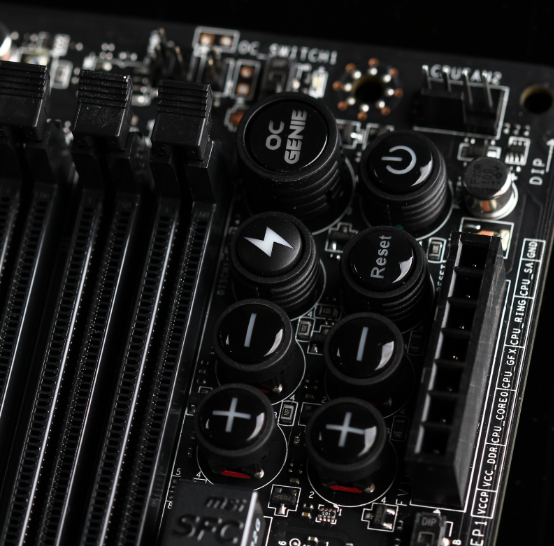
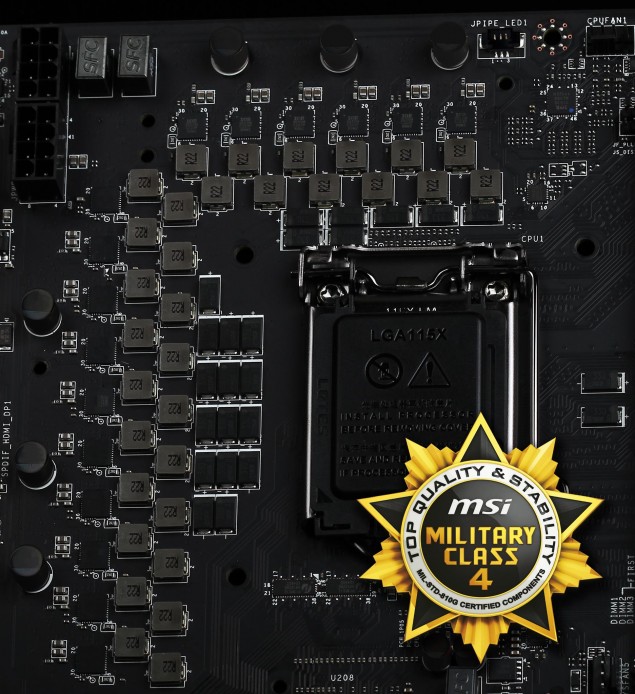
Source: WCCFTech
Biostar Z87
Source: GamersNexus, Hardware.info
During our time on Z87, Biostar never really jumped into the picture. There were murmurings of their Puro audio solution, using pairs of large caps to help filter out analog signals. When it comes to the new Haswell generation, we got wind of several boards coming to market:
Biostar Hi-Fi B85S3 (mATX)
Biostar Hi-Fi H87S3+ (mATX)
Biostar Hi-Fi Z87W
Biostar Hi-Fi Z87X 3D
Gone are the years of orange Biostar boards – whereas everyone seems to be moving away from blue, Biostar are bringing it back with their higher end range.
Biostar Hi-Fi B85S3
First up is a B85 board in a micro-ATX form factor:
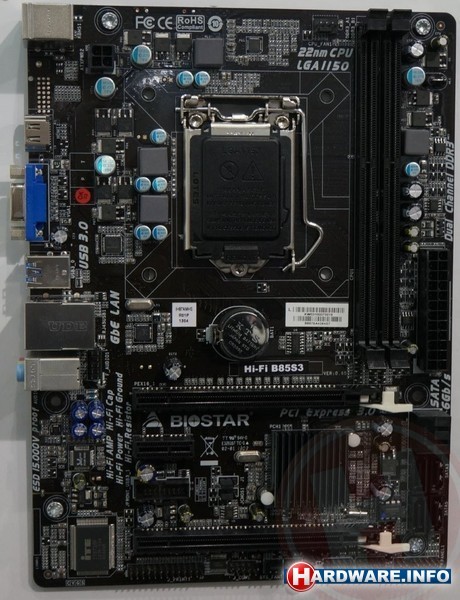
While Biostar are keen to announce the use of USB 3.0, the LGA1150 socket, PCIe 3.0, SATA ports and DDR3, the text relating the audio interests me more. Here we have ‘Hi-Fi AMP’, ‘Hi-Fi Cap’, ‘Hi-Fi Power’, ‘Hi-Fi Ground’ and ‘Hi-Fi Receiver’, which could mean we have a half decent audio solution on a cheap end board, but I would not hold my breath – judging by the three audio outputs we probably have an ALC889 onboard.
The PCIe layout suggests an x16/x1/x1/x4 layout due to the B85 chipset, and the SATA ports have two upright and four coming out of the board. The Rear IO looks a little bare but we clearly have a HDMI, VGA, and a few USB 3.0 ports.
Biostar Hi-Fi H87S3+
Moving up the chain to H87 we have a similar looking board to examine, especially in terms of IO.
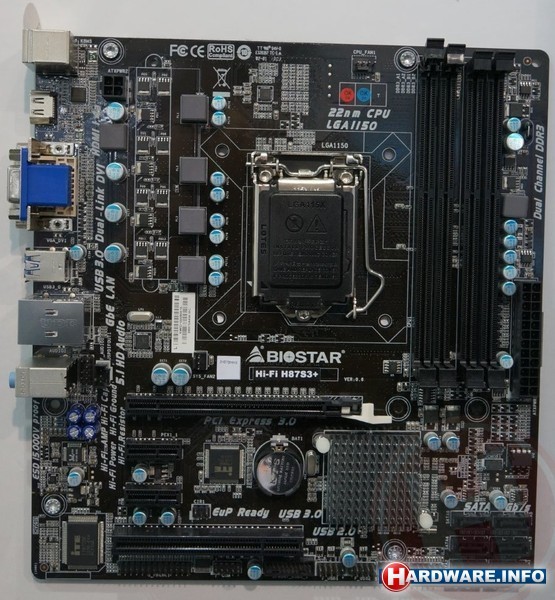
The PCIe lane allocation is sporting a PCI connector at the bottom, and the SATA ports (there seems to be six under the logo) are all coming out of the board. The audio solution still looks like an ALC889 however. On the IO the VGA looks like it is now above a DVI connector.
Biostar Hi-Fi Z87W
The full ATX models from Biostar are starting to actually look nice, rather than the orange of yesteryear. The Z87W comes in focused all within the Puro Hi-Fi:

So Puro was on Z77 but unfortunately we did not have a deep look at it. With Z87 I do hope they are using the ALC1150 as well as supporting 600 ohm headphones, though without technical specifications I can only speculate. Biostar have never been one for multi-GPU setups, but we get what looks like an x8/x8 allocation on the GPUs, as well as power/reset buttons and a two-digit debug LED.
Biostar Hi-Fi Z87X 3D
Another step up the ladder and we get a clear shot of the next motherboard up the range, the Z87X 3D.
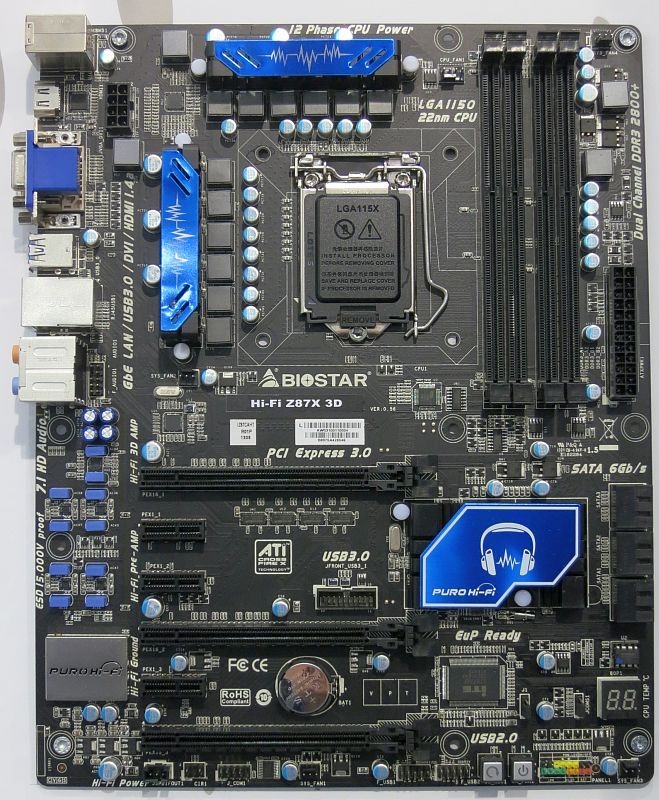
We can see Biostar are slowly upping the number of phases for the CPU (it states on the top of the board 12), and the Puro Hi-Fi takes up a good portion of the left hand side of the board. PCIe allocation looks like an x8/x4/x4 (or x8/x8 + x4), and we get proper power/reset buttons this time around. It is worth noting the very strange location of the USB 3.0 connector – right in the middle of the motherboard. This means a cable stretched across the board, and no luck if you decide to use a triple slot GPU or large PCIe x1 card.
EVGA Z87
With most of the recent releases, EVGA has not been a big player on release day, typically only releasing one or two products with up to three or four motherboards per chipset in total - for example on Z77 we had the FTW and the Stinger. I was lucky enough to catch one of Jacob Freeman’s tweets today showing off their Z87 motherboard:
It looks like we have a new BIOS, that the EVGA board is, as always, looking substantial in terms of heatsinks and PCIe. EVGA employ K¦ngp¦n, one of the world’s top overclockers, who constantly uses EVGA boards to break overclocking world records when he can. Of course I would like to see what EVGA have up their sleeve for this generation.


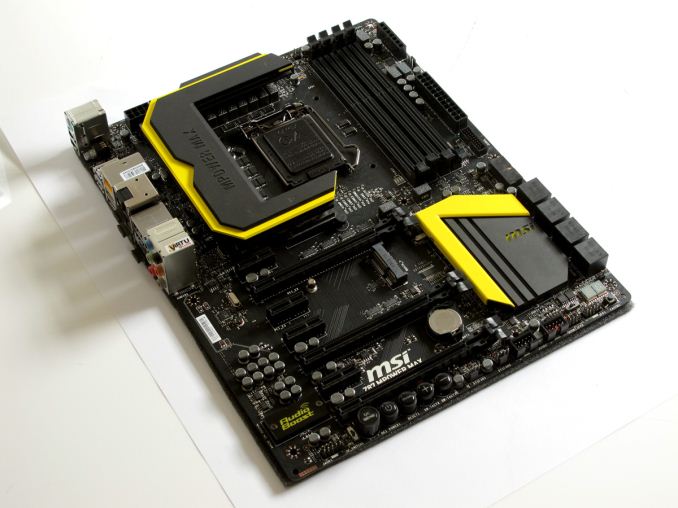
_575px.jpg)







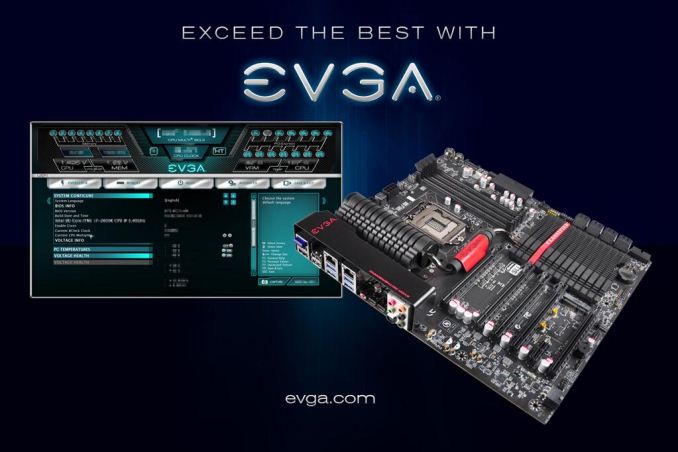








70 Comments
View All Comments
silenceisgolden - Sunday, May 26, 2013 - link
Well if everyone has settled on USB, why put PS/2 on anything besides maybe 1 high-end/gaming motherboard per brand. I think most people have settled on USB, and the ratio of motherboards that have PS/2 ports to motherboards sold is way greater than the ratio of people using PS/2 ports to the amount of people with PS/2 ports.JDG1980 - Thursday, May 23, 2013 - link
You won't see all these features together because they are designed for different audiences. mSATA and Wi-Fi are most useful on Mini-ITX boards where portability and size are issues; full size workstations generally use regular SATA, and most enthusiasts have Ethernet connections on the desktop.Adding more than the standard number of SATA ports or USB3 headers might not be supported by the base chipset, thus requiring extra ICs, driving up costs. This means you're only going to find it in an enthusiast board. Of course, if you have an enthusiast board, you could always add another SATA host adapter and/or USB3 adapter to one of your PCIe slots.
silenceisgolden - Sunday, May 26, 2013 - link
With an enthusiast board, however, most of the PCIe slots will be filled and on my current rig I already use a USB3 adapter since the motherboard is old. However, I'd like to get rid of it, not continue with it on my new motherboard/cpu combo. Most motherboards at the enthusiast level seem to have 10 SATA ports so I'm not as worried about that. I'll give you that mSATA might not be great, but I can think of uses for Wi-Di, and I believe that needs to be motherboard solution (or maybe an adapter, but that's another $50-70 on top of the price).EnzoFX - Wednesday, May 22, 2013 - link
So for the ASRock ITX board, the 8pin cpu connector needs to be on the edge? Isn't it more common to see it in the middle? So Asus has one on the edge and suddenly it's a necessity? =pNot arguing the benefit, just saying.
RoslynWan12 - Wednesday, May 22, 2013 - link
If you think Howard`s story is unbelievable,, a month-ago my cousinns step-daad also broght in $5355 grafting a eighteen hour week from their apartment and there friend's half-sister`s neighbour has been doing this for 7-months and got paid more than $5355 part time at there computer. the instructions available on this page Bow6.comTAKE A LOOKkrutou - Sunday, May 26, 2013 - link
hurrah for pyramid schemestackle70 - Wednesday, May 22, 2013 - link
To be honest, and this may seem very vain to some, I just look for whichever high end motherboard has the best aesthetic to go with my build. I trust that once you get to a certain point ($~200+), all the big name boards (ASUS/Gigabyte/ASRock/MSI) are going to be quality stuff with more features than I will use.So it all comes down to aesthetics for me. I bought the ASRock z68 extreme7 gen3 because I liked the black/gold look to go with my lightning 7970s (MSI didn't have any black/yellow motherboards out yet at the time). And I always find ASUS' black and red stuff hideous on the ROG boards, so I stay away.
Razorbak86 - Wednesday, May 22, 2013 - link
That's funny. I love red and black boards, and I think all gold-colored boards looks gaudy. I went with the ASUS Maximus V Formula.n0x1ous - Thursday, May 23, 2013 - link
I hate both red/black and black/gold. for me I prefer blue/black or green/black so Gigabyte gets the nodFlunk - Wednesday, May 22, 2013 - link
This article is great, it gives a great overview of all these boards that will help me better recommend boards to all the people who ask me about it this year. Looking forward to the in-depth reviews later.